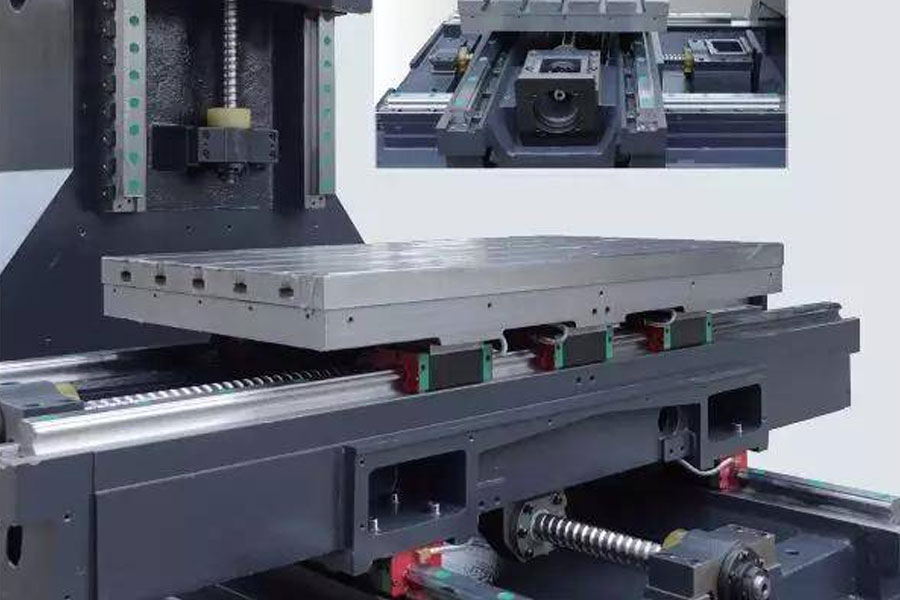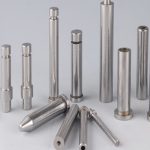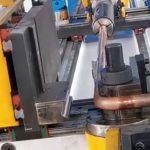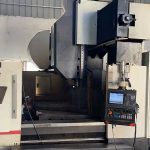The Characteristics Analysis of Machining Surface Micro-profiles
|
Taking the machining standard sample as the object, the difference in the surface roughness of different machining surfaces is studied, the characteristics of the surface topography obtained by different machining are analyzed, and the surface topography with different roughness obtained by the same machining method is observed. . The results show that: the surface morphology and roughness values of the standard samples obtained by various machining methods are different to different degrees; the density of the fine structure and the peak profile height of the different machining surface morphologies are different, which is different from that. The processing mechanism is related; the surface morphology structure of different roughness obtained by the same kind of machining has self-similarity, and has typical morphology and structure characteristics, which can be used to distinguish different machining methods. |

With the rapid development of science and technology, the quality requirements for various mechanical products are getting higher and higher. The surface morphology and structure not only affect the mechanical properties of the mechanical system such as friction and wear, contact stiffness, fatigue strength, mating properties, transmission accuracy, sealing performance, and detection accuracy, but also directly affect the performance, life and appearance of the machine.
In micro-machines, the surface micro-morphology is also closely related to its friction, wear, lubrication and other friction properties.
The surface morphology (geometry and texture, etc.) of the machined surface depends on the mutual positional relationship between the tool and the workpiece during the cutting movement. It is not only related to the specific cutting method and cutting conditions, but also to the dynamics of the machine tool structure The characteristics, cutting tools and the material and mechanical characteristics of the workpiece are related [4]. The study of the characteristics and internal laws of the micro-morphology of different machining surfaces is of important reference value for in-depth understanding of the machining mechanisms of different machining methods and their differences, and it also provides a technical basis for machining.
The author of this paper takes machining (turning, planing, end milling, flat milling, boring, flat grinding) standard sample blocks as the object, studies the difference in surface roughness obtained by different machining methods, and analyzes different machining methods The characteristics of the surface morphology and structure were obtained, and the morphology law of the surface with different roughness obtained by the same machining method was observed. Thus, understand the characteristics of different machining methods and their differences.
1 Differences in surface roughness of different machined surfaces
Surface topography instrument can measure 28 kinds of surface topography parameters. Select the sampling length to be 5mm and the sampling interval to be 1.25 μm to measure the surface topography parameters of the machined standard sample block. The commonly used surface profile height average value Ra is selected as the roughness evaluation parameter to analyze the difference in surface roughness of different machined surfaces. Different machining methods obtain the Ra value of different roughness standard samples (take the average of 3 measurements), and the difference between the measured roughness value and the roughness of the sample block.
- (1) There are different errors in the measured roughness values of the surface topography of the same roughness standard sample obtained by different machining methods. For example, for different processing methods, the measured roughness values and differences of the surface of the standard sample block with a roughness of Ra 0.8 μm are different. Small to large), the measured roughness value is smaller than the sample block roughness value in order of boring, end milling, and flat milling (from small to large).
- (2) The error between the measured roughness value of the surface with different roughness obtained by the same machining method and the roughness value of the standard sample is also different. For example, for turning processing, the surface roughness of the standard specimens obtained is Ra 0.8 μm, 1.6 μm, 3.2 μm, 6.3 μm, and the change trend of the error between their measured roughness is different, and the roughness value is Ra0. The measured roughness values of 8μm, 1.6μm and 6.3μm are larger than the roughness of the standard sample block; when the roughness value is Ra3.2 μm, the measured roughness value is smaller than the roughness value of the standard sample block. However, the measured errors of the four roughness standard specimens processed by end milling are all negative, that is, the measured roughness values are all less than the roughness values of the standard specimens.
The micro-morphology characteristics of different machined surfaces are obtained by using different machining methods (turning, boring, end milling, planing, flat milling, flat grinding) for standard samples with the same roughness (Ra0.8 μm) There is a big difference in surface morphology
- (1) The density of the microstructure of different machined surface morphologies is different, from low to high, they are flat milling, planing, end milling, flat grinding, boring, and turning.
- (2) The surface morphology and structure of different machined surfaces have certain similarities. For example, turning and boring are spring-like structures; planing and flat milling are wave-like structures; end milling and flat grinding are serrated structures.
- (3) The peak change amplitude of the surface profile is flat grinding, turning, planing, end milling, boring, and flat milling in descending order, which is related to the processing mechanism of various machining methods.
The surface roughness value of the grinding process is relatively high, and the main influencing factors are:
- ① The cutting edge (abrasive grain) of the grinding wheel is not a continuous straight line, which will leave a certain residual area on the workpiece after grinding
- ②In the grinding process, the plastic deformation of the metal on the surface of the workpiece causes the cutting temperature to rise continuously, which accelerates the wear of the grinding wheel and causes serious extrusion;
- ③The selection of parameters such as grinding amount, grinding fluid and grinding allowance have a certain influence on the surface roughness of the workpiece.
3 Surface topography characteristics of the same processing method with different roughness
The surface profile curve of the standard sample block with different roughness (Ra0.8μm, 1.6μm, 3.2μm) is obtained by the flat milling machine. The sampling length is 3.75mm, the sampling interval is 1.25μm, and the number of sampling points is 3,000 points. .
- (1) The surface profile with roughness of Ra 0.8 μm, 1.6 μm, 3.2 μm obtained by the flat milling machine has a similar wavy structure, which shows that the surface topography structure with different roughness obtained by the same machining method has Similarity, and has typical morphological and structural characteristics, which can also be used to distinguish different machining methods.
- (2) The peak value of the flat milling surface profile increases with the increase of the roughness value, which is consistent with the Ra value parameter of the average height of the surface profile profile.
- (3) The density of the surface micro-topography structure decreases with the increase of roughness, and the distance between peaks increases.
4 Conclusion
- (1) There are errors of varying degrees in the surface topography roughness values of the same roughness standard samples obtained by different machining.
- (2) When using the same machining method to obtain surfaces with different roughnesses, the error between the measured roughness value and the roughness value of the standard sample is also different.
- (3) Different machined surface morphology, fine structure density and peak profile height are all different, which is related to the processing mechanism.
- (4) The surface morphology and structure obtained by different machining methods have a certain degree of similarity. For example, turning and boring are spring-like structures; planing and flat milling are wave-like structures; end milling and flat grinding are serrated structures.
- (5) The surface morphology and structure of different roughness obtained by the same machining method are similar, and have typical morphology and structure characteristics, which can be used to distinguish different machining methods
Link to this article: The Characteristics Analysis Of Machining Surface Micro-Profiles
Reprint Statement: If there are no special instructions, all articles on this site are original. Please indicate the source for reprinting:https://www.cncmachiningptj.com/,thanks!
 PTJ CNC shop produces parts with excellent mechanical properties, accuracy and repeatability from metal and plastic. 5 axis CNC milling available.Machining high-temperature alloy range inclouding inconel machining,monel machining,Geek Ascology machining,Carp 49 machining,Hastelloy machining,Nitronic-60 machining,Hymu 80 machining,Tool Steel machining,etc.,. Ideal for aerospace applications.CNC machining produces parts with excellent mechanical properties, accuracy and repeatability from metal and plastic. 3-axis & 5-axis CNC milling available.We will strategize with you to provide the most cost-effective services to help you reach your target,Welcome to Contact us ( [email protected] ) directly for your new project.
PTJ CNC shop produces parts with excellent mechanical properties, accuracy and repeatability from metal and plastic. 5 axis CNC milling available.Machining high-temperature alloy range inclouding inconel machining,monel machining,Geek Ascology machining,Carp 49 machining,Hastelloy machining,Nitronic-60 machining,Hymu 80 machining,Tool Steel machining,etc.,. Ideal for aerospace applications.CNC machining produces parts with excellent mechanical properties, accuracy and repeatability from metal and plastic. 3-axis & 5-axis CNC milling available.We will strategize with you to provide the most cost-effective services to help you reach your target,Welcome to Contact us ( [email protected] ) directly for your new project.
Link to this article:The Characteristics Analysis Of Machining Surface Micro-Profiles
Reprint Statement: If there are no special instructions, all articles on this site are original. Please indicate the source for reprinting:Alloy Wiki,thanks!^^







